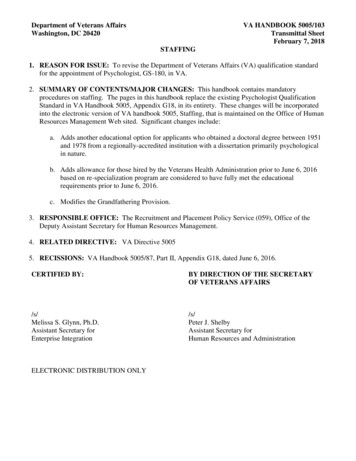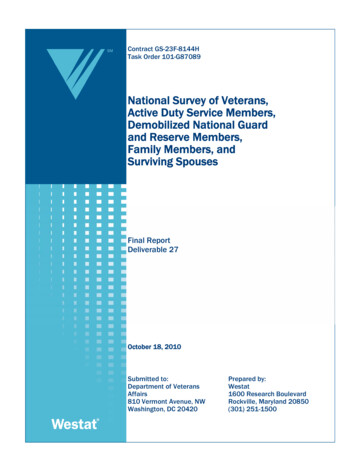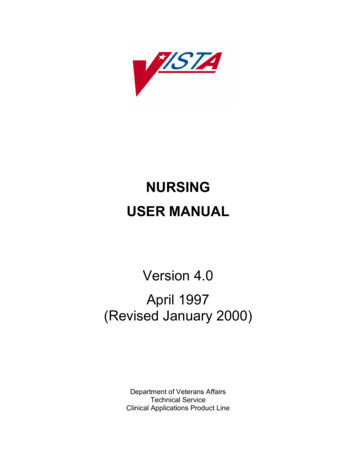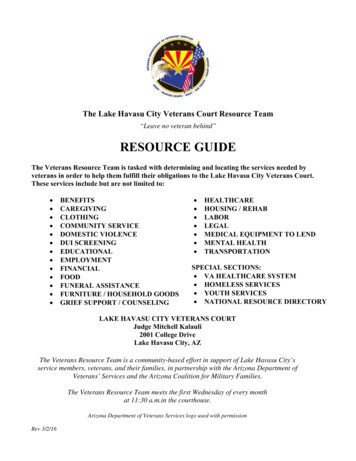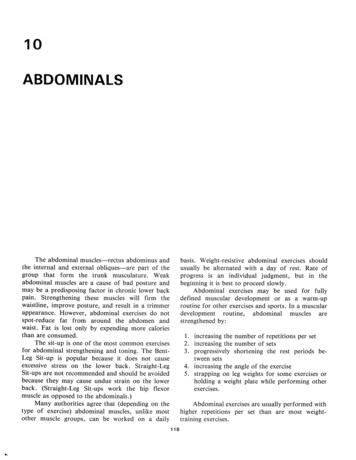
Transcription
10ABDOMINALSThe abdominal muscles—rectus abdominus andthe internal and external obliques—are part of thegroup that form the trunk musculature . Weakabdominal muscles are a cause of bad posture andmay be a predisposing factor in chronic lower backpain . Strengthening these muscles will firm thewaistline, improve posture, and result in a trimmerappearance. However, abdominal exercises do notspot-reduce fat from around the abdomen andwaist . Fat is lost only by expending more caloriesthan are consumed.The sit-up is one of the most common exercisesfor abdominal strengthening and toning . The BentLeg Sit-up is popular because it does not causeexcessive stress on the lower back . Straight-LegSit-ups are not recommended and should be avoidedbecause they may cause undue strain on the lowerback . (Straight-Leg Sit-ups work the hip flexormuscle as opposed to the abdominals .)Many authorities agree that (depending on thetype of exercise) abdominal muscles, unlike mostother muscle groups, can be worked on a dailybasis . Weight-resistive abdominal exercises shouldusually be alternated with a day of rest . Rate ofprogress is an individual judgment, but in thebeginning it is best to proceed slowly.Abdominal exercises may be used for fullydefined muscular development or as a warm-uproutine for other exercises and sports . In a musculardevelopment routine, abdominal muscles arestrengthened by:1. increasing the number of repetitions per set2. increasing the number of sets3. progressively shortening the rest periods between sets4. increasing the angle of the exercise5. strapping on leg weights for some exercises orholding a weight plate while performing otherexercises.Abdominal exercises are usually performed withhigher repetitions per set than are most weighttraining exercises.118
119Conditioning Exercises : AbdominalsINCREASINGTHENUMBEROFREPETITIONSAlways do warm-up exercises before lifting weights.Start with a minimum of 8 repetitions with egixnn weight . !fo minimum of 8repetitions cannot be completed, the weight is too heavy for you and theresistance should be lowered until 8 repetitions can be completed.When 12 repetitions can be successfully completed, the weight should beincreased by 5-10 pounds . When 12 repetitions can be completed with theincrease in pounds, the weight may be increased again.Work up to 15'20 repetitions per set for muscle maintenance, endurance, andtone.When performing exercises with free weights, it is recommended that 2-6sets for each particular muscle group be used.CAUTIONBeginners are encouraged to use free weights with a spotter present . Certainexercises will require a spotter regardless of skill level (e .g ., squats).ABDOMINAL EXERCISE ROUTINEMuscleExerciseTitleWarm-up/Abdominals/Hip Flexors53Supine Leg RaiseAbdominals/Hip Flexors54Jackknife Sit-upAbdominals/Hip Flexors55Bent-Leg Sit-upUpper Abdominals/Hip Flexors56Bent-Knee CrunchAbdominals/Hip Flexors57Incline Bench Sit-up with VariationsAbdominals/Hip Flexors58Nautilus Abdominal ChairLower Abdominals59Vertical Bench Bent-Knee RaiseLower Abdominals/Hip Flexors60Vertical Bench Straight-Leg RaiseLower Abdominals/Hip Flexors61Incline Leg RaiseInternal/External Obliques62Side Bends with DumbbellInternal/External Obliques63Side Bends/Hyperextension BenchUpper Abdorninals/Hip Flexors64Straight-Leg Sit-up/HyperextensionBenchAbdorninals/Shoulder Extensors65Exercise Wheel
120RRDS Clinical Guide . Physical Fitness: A Guide for Individuals with Lower Limb LossEXERCISE 53. SUPINE LEG RAISEPURPOSEWarm-up and strength conditioning of the lower abdominal muscles and hip flexors.PROCEDUREn Lie flat on your back with arms at sides and legs close together and straight out.n Keep the heels close together while raising the legs 3 to 6 inches off the floor.n Tighten abdominal muscles and tilt pelvis to flatten the lower back against the floor.This will stabilize the pelvis and protect the back . Hold the legs in this position for afew seconds . Increase the time gradually, week by week.n For beginners, three sets are suggested with a 30-second to 1-minute rest periodbetween each set.MODIFICATIONSThe prosthetic knee is locked in the straight position to prevent it from flexing . A personwith AK amputation who does not have a locking knee unit can support the prosthesisand prevent it from flexing by placing the sound limb underneath the prosthesis or bypressing the heels together.SKILL LEVELBeginner .CAUTIONThis exercise can be stressful tothe lower back . Omit if low backproblems are present.Linda Pedersen exercises with her above-knee quad socket, Mauch SNS Knee Unit,and Otto Bock SACH Foot .
121Conditioning Exercises : AbdominalsEXERCISE 54 . JACKKNIFE SIT-UP (ALSO KNOWN AS V-UP SIT-UP)PURPOSEStrengthens the upper and lower abdominal muscles and hip flexors.PROCEDUREn Lie on the floor in a supine position with legs straight out in front and arms extendedbehind the head.n Keep the elbows and knees straight throughout the exercise.n Simultaneously bring legs and arms together in a position as close to a vertical positionas possible while bending from the waist.n Lower the limbs to the supine position to complete each repetition.n Do not rest while in the supine position.n Inhale as you lower the legs and arms to a supine position and exhale as you come upto a vertical position.MODIFICATIONSThe prosthetic knee should be locked in extension to prevent it from flexing . A flexiblebrim above-knee socket may help in flexing the hip further while reaching the verticalposition.SKILL LEVELAdvanced.CAUTIONMs . Pedersen keeps her back verystraight as she reaches the topposition because she has beenconditioning for many years . Beginners and those with chronicback pain should not attempt toreach as high, but only try to reachthe mid-calf, shins, or ankles . Startwith the Bent-Knee Crunch (Exercise 56) or the Nautilus AbdominalChair (Exercise 58) until you areready to do the Jackknife Sit-ups.As strength of the abdominal muscles is developed, there will be lessrisk of possible back injury in dailyactivities and other exercise routines .
122RRDS Clinical Guide . Physical Fitness : A Guide for Individuals with Lower Limb LossEXERCISE 55 . BENT-LEG SIT-UPPURPOSEStrengthens the abdominal muscles and hip flexors.PROCEDUREn Lie flat on your back with hands clasped behind your head.n Bend the knees to about a 45-degree angle and have someone hold your feet to thefloor.n Bend at the waist and bring your elbows up to your knees.n Lower your body slowly and let your shoulders touch the mat.n Exhale as you bring your body up and inhale as you lower it down.n Repeat the exercise without pausing in order to keep tension on the abdominal muscles.MODIFICATIONSFor the person with AK amputation, the suspension of the sockets must be good andtramlines low enough to allow adequate hip flexion . To work the oblique muscles, twistyour trunk as you raise it . Do not come up all the way if you are not able to complete atleast 15 repetitions . If you are a beginner, start by only raising your head to complete asit-up . If you can do that, raise your shoulders off the mat on the next set . Later, proceedto a half sit-up and then to a full sit-up as your strength increases.SKILL LEVELIntermediate.NOTEThe person with a unilateral amputation will experience greater tension on the sound limb asboth legs are held down.Bent-Leg Sit-ups are easier on the back than are Straight-Leg Sit-ups . They also allow forbetter isolation of the abdominal muscles because they do not require as much use of the hipflexor muscles . Many beginning exercisers use this type of sit-up at first, since climbing ontoand balancing on an incline bench is difficult for some people . However, the advantage of theIncline Bench Sit-up (Exercise 57) is that no partner is needed .
123Conditioning Exercises : AbdominalsSamantha Ellis is assisted by Greg Mannino .
124nxooClinicalGuide . Physical Fitness : A Guide for Individuals with Lower Limb LossEXERCISE 5 6 . BENT-KNEE CRUNCHPURPOSEStrengthens the upper abdominals and hip flexors.PROCEDUREII Lie ooa padded surface and place your legs on a bench so that your thighs are at a45-degree angle.n Clasp your hands behind your head and pull your head and upper body from the floorusing only the abdominal muscles.NI Lead with the elbows as shown in the photos . Beginners should start with a partialsit-up, lifting just the head and shoulders off the mat (see photo).11 As strength and endurance are developed, increase to a45-dc8rcc sit-up . This exerciseis very effective when 15-25 sit-ups can be completed in succession with no pauses inbetween repetitions.VARIATIONTo work the intercostal muscles as well, twist to left and right sides alternately as you raiseyour torso to your legs . The routine for working the intercostals will be : center, right;center, left ; center, right, etc.SKILL LEVELAdvanced .CAUTIONIf you begin to feel back strain, raise only theshoulders and haud, and only as high as iscomfortable .
125Conditioning Exercises : AbdominalsGreg Mannino does a half sit-up, demonstrating the appropriate position for a personwho has a back problem or is a beginner . (Notice that the low back remains incontact with the floor .)Samantha Ellis assists Mannino by holding his legs in place while hedoes a full sit-up .
126RRDS Clinical Guide . Physical Fitness : A Guide for Individuals with Lower Limb LossEXERCISE 57 . INCLINE BENCH SIT-UP WITH VARIATIONSPURPOSEDevelops and strengthens the upper abdominal muscles and hip flexors.PROCEDUREn Adjust the sit-up board to the desired height.n Sit on the incline board and place your feet underneath the foot bar . Flex your knees toabout a 45-degree angle.n Place your hands behind your head or across your chest (whichever is mostcomfortable) and tuck in your chin . (Hands behind the head is the most difficultposition .)n Arms may be held in a variety of positions but must remain fixed during the exercise tokeep from swaying and to minimize excessive body movement . Concentrate on pullingup your body using only the abdominal muscles.n Lie back flat on the bench to begin the sit-up.n Bend at the waist and bring yourself to an upright position (45 degrees) until yourelbows are at about the same height as your knees . Slowly return to the startingposition.n Repeat the exercise without pauses in order to maintain tension on the abdominalmuscles . To keep tension on the abdominal muscles, do not come up too high or restyour back on the bench on the way down.VARIATIONSFor increased resistance, hold the weights behind your head or on your chest while doingsit-ups . To also work the oblique muscles, twist the upper body to each side, alternatingeach turn (i .e., center, left ; center, right ; center, left ; etc .).MODIFICATIONSThe prosthesis should have good socket suspension ; the AK prosthesis should have aflexible brim socket when possible . Before the legs are placed underneath the bar, positionthe prosthesis with your hands or get assistance getting on and off the incline bench.SKILL LEVELIntermediate .NOTEThe greater the angle of the bench, the more difficult the sit-up . Beginners should start withthe lowest angle . Two types of adjustable incline benches are shown . The incline benchshown in the first two photos supports the bent leg at a 45-degree angle . A more advancedincline bench with no bent-leg support is shown in the latter two photos.CAUTIONIf you have back problems, keep the lower back on the bench and raise your body no furtherthan a half sit-up . Raise the head and shoulders only as high as is comfortable .
127Conditioning Exercises : AbdominalsJohn Everett performs an Incline Bench Sit-up using ActivSleeve Suspension Sleevewith exoskeletal prostheses and Seattle Feet.Mike Nitz performs an Incline Bench Sit-Up using the Flex-Foot .
128onoSClinical Guide . Physical Fitness : A Guide for Individuals with Lower Limb LossEXERCISE 57, INCLINE BENCH Sff-UP WITH VARIATIONS (Continued)Linda Pedersen demonstrates asit-up on an incline bench with nobent-leg support . She is using theExoskeletal Quad Suction Socket,Mauch SNS Knee Unit, and OttoBookSACH Foot.Albert R a pp o po rt demonstrates an Incline Bench Sit-Up with the bench raised to itsmaximum position for greater difficulty .
129Conditioning Exercises : AbdominalsEXERCISE 58 . NAUTILUS ABDOMINAL CHAIRPURPOSEStrengthens the abdominal muscles and hip flexors.PROCEDURE Sit on the bench and place your feet beneath the ankle pads . Sit straight and positionthe upper pads so that you can press against them with your shoulders, upper arms,and chest. Cross your arms in front of your chest. Bend from the waist and push down against the upper pads as far as possible. Flex your trunk from the waist, moving your upper body forward and down.10 Pause momentarily, then slowly let yourself back up to the starting position.SKILL LEVELBeginner.Samantha Ellis demonstrates the starting position .Ellis pauses before returning to the starting position .
130RRDS Clinical Guide . Physical Fitness : A Guide for Individuals with Lower Limb LossEXERCISE 58 . NAUTILUS ABDOMINAL CHAIR (Continued)Greg Mannino in the startingposition for exercise.NOTEThe Nautilus chair places little stresson the back and resistive weight increases the effectiveness of the exercise . Another advantage of this chair isthat an assistant is not needed to holdthe legs down .Mannino in the finish position .
131Conditioning Exercises : AbdominalsEXERCISE 59 . VERTICAL BENCH BENT-KNEE RAISEPURPOSEDevelops the lower abdominal muscles and hip flexors.PROCEDUREn Place your forearms against the pads of the vertical bench and lock your shoulders outto help support your body weight.n Keep your back against the back rest . Let your legs hang in a vertical position and thenbend your knees and bring them up to waist level or slightly higher.n Exhale as you raise your legs and inhale as you lower them . Straighten the legs as theyare being lowered.n When bringing your legs up, try not to swing your body . Keep your back against theback rest and use only the abdominal muscles to raise the legs.MODIFICATIONThe sound leg may be pressed against the prosthesis to maintain its position and aid inlifting it.SKILL LEVELIntermediate.Linda Pedersen pauses before lowering her legs to thestarting position .
132RRDS Clinical Guide . Physical Fitness : A Guide for Individuals with Lower Limb LossEXERCISE 60 . VERTICAL BENCH STRAIGHT-LEG RAISEPURPOSEDevelops the lower abdominal muscles and hip flexors.PROCEDUREn Place your forearms against the pads of the vertical bench and lock your shoulders outto help support your body weight . Keep your back against the back rest.n Starting with the legs in the vertical position, bring them up with knees straight untilthe legs are parallel to the floor or slightly higher . Hold the position momentarilybefore lowering the legs, making each repetition more challenging.n Exhale as the legs are raised and inhale as they are slowly lowered to the startingposition. Try to keep your back against the back rest and concentrate on using only theabdominal muscles to lift the legs.MODIFICATIONSIndividuals using an AK prosthesis without a locking knee unit that locks, should keep thesound limb underneath the prosthesis at the heel or keep the legs pressed tightly againsteach other to prevent the prosthetic knee from flexing and to aid in lifting the prosthesis.Good prosthetic suspension is important . Linda Pedersen uses a quadrilateral suctionsocket with a Hosmer Red Dot valve . John Everett uses ActivSleeves with a small USMSAdjustable Leak Rate Valve to create suction type suspension. If the exercise is toodifficult to complete, raise your legs only part way or use Exercise 61 until you build upadequate strength.SKILL LEVELIntermediate .
133Conditioning Exercises : AbdominalsLinda Pedersen demonstrates theStraight-Leg Raise . Her MauchSNS Knee Unit is locked in anextended position so that theknee will not flex.John Everett does the StraightLeg Raise on a different type ofvertical abdominal bench . Hekeeps his legs up by extending hisknees and pressing his heelstogether .
134RRDS Clinical Guide . Physical Fitness: A Guide for Individuals with Lower Limb LossEXERCISE 61 . INCLINE LEG RAISEPURPOSEStrengthens the lower abdominal muscles and hip flexors.PROCEDUREn Adjust the incline bench to about a 25-30 degree angle . Position your head at the topof the bench and grasp the bar behind your head with both hands.n Keep your legs straight and together . Inhale as you raise both legs to at least a verticalposition above the hips.n Keep tension on the abdominal muscles at all times . This may mean not bringing thelegs all the way up and not letting the heels rest on the bench when you lower them.n Do not hold a position or rest during the exercise . While exhaling, lower the legs untilthey are about 3 inches off the bench . Bring the legs back up and repeat the exercise.VARIATIONIf you wish to include working your oblique muscles, perform one repetition with legsstraight as you raise them ; the next by twisting your hips as you raise your legs towardyour right shoulder, bring legs straight back toward your head, down, and then to the leftshoulder. Repeat the sequence, starting with the legs in the center.MODIFICATIONIf you are working with a knee unit on an AK prosthesis that does not lock in an extendedposition, keep the sound limb under the prosthesis at the heel in order to lift it and tomaintain a straight knee.SKILL LEVELAdvanced.CAUTIONFor those who experience low back pain, the knees can be bent as the legs are raised andstraightened as the legs are lowered . Keep the lower back in contact with the bench at alltimes .
135Conditioning Exercises : AbdominalsLinda Pedersen demonstrates the Incline Leg Raise .
136RRDS Clinical Guide . Physical Fitness : A Guide for Individuals with Lower Limb LossEXERCISE 62 . SIDE BENDS WITH DUMBBELLPURPOSEStrengthens the internal and external oblique and erector spinae muscles . Limbers andfirms the muscles underlying the "love handles ."PROCEDUREn Stand with your feet about shoulder-width apart.n Hold the dumbbell in one hand and place the other hand behind your head (or on yourwaist if you need stability at first).n Stand erect and bend to the side at the waist (straight over the hips).n Return to the starting position . Keep your back straight and do not bend at the hips orknees, only from the waist . Continue the exercise in this manner, bending as far aspossible from side to side.n Change arm and dumbbell positions and bend again from side to side.n Work up to 15-20 repetitions per side before a rest period . Gradually increase thenumber of sets to three or four per side.MODIFICATIONThe exercise may be performed sitting down.SKILL LEVELBeginner .NOTEBeginners should perform this exercise without the dumbbells for the first several workouts.Start with a lightweight dumbbell and work up to heavier weights . Do not lift weights thatprohibit 1 5-20 repetitions . Try beginning with 5 pounds and increase the weight by 5 poundsat a time . Concentrate on performing more repetitions, not on lifting heavier weights . Youwant to tone the obliques and waistline, not add muscle bulk .
137Conditioning Exercises : AbdominalsGreg Mannino demonstrates the exercise .
138nnDmClinical Guide . Physical Fitness : A Guide for Individuals with Lower Limb LossEXERCISE 63 . SIDE BENDS/HYPEREXTENSION BENCHPURPOSEStrengthens the internal and external oblique muscles.PROCEDUREII Position yourself on your side on the seat of the hyperextension bench while crossingyour legs underneath the adjacent bar for support.II Lower your trunk as far as possible.0N Bring your trunk to the highest upright position while remaining on your side.II Legs can be switched and the body turned around so that both sides can be worked.MODIFICATIONSIf this position is too difficult, you may work the internal and external obliques whilestanding or sitting by bending side-to-side or twisting the trunk (see Exercise 62) . Holdinga dumbbell or weight plate in one hand for increased resistance can be effective.SKILL LEVELAdvanced.NOTEThe position is difficult to assume and maintain, particularly on the first try . While learningthis exercise, you should always be assistedby a spotter .Albert Rappoport usesthaAodvS!eeeSuspension System toprovide the necessarysupport .
139Conditioning Exercises : AbdominalsEXERCISE 64 . STRAIGHT-LEG SIT-UP/HYPEREXTENSION BENCHPURPOSEWorks the upper abdominals and hip flexors.PROCEDUREn Sit on the hyperextension bench and position your feet underneath the bar for support.n Bend backward until your upper body is lower than the bench.n Perform a sit-up by raising yourself back to an upright position using only theabdominal muscles.n Do not bend too far forward when you return to the upright position because that willlessen the tension on the abdominal muscles.MODIFICATIONSActivSleeve Suspension Sleeves create a suction-type suspension which imparts confidencethat the legs will not displace, especially for those with bilateral amputation . Seattle feetare used on the exoskeletal prostheses with New Life Laboratories PM Liner and NewSkin cosmetic covering.SKILL LEVELAdvanced .NOTEThis exercise is particularly challenging because it is difficult to get into the startingposition on the hyperextension machine.CAUTIONThis exercise places great stress onthe lower back . Avoid in the presence of any back problems.John Everett performsan advanced variationof the sit-up exercise .
140RRDS Clinical Guide . Physical Fitness : A Guide for Individuals with Lower Limb LossEXERCISE 65 . EXERCISE WHEELPURPOSEStrengthens the abdomen, shoulder extensors, and hip flexors.PROCEDURE 1 : BEGINNING POSITION (KNEES ON GROUND)n Lie face down on an exercise mat.n Starting with the knees on the ground, grab the handles on either side of the exercisewheel and roll it out in front.n Slowly extend the arms and stretch the body out straight until the back is at leastparallel to the ground . Keep the wheel in contact with the ground at all times.n Bring the body to an upright position . No part of the body from the knees up shouldbe in contact with the floor . Hold the extended position for a few seconds.n Increase the hold time by a few seconds each time you do the exercise in order to buildstrength in the abdomen and lower back.n Repeat 5-10 times for each set ; three sets are recommended.PROCEDURE 2 : ADVANCED POSITION (KNEES OFF GROUND)n Begin from a standing position.n Place the exercise wheel on the floor and roll it forward.n Extend the legs and arms as the body is lowered to an outstretched position, as seen inthe photo . No part of the body may touch the ground.n Raise the wheel and body back to a standing position while legs and arms continue tobe extended.n The wheel remains in contact with the floor until it reaches the toes . The body is nowupright and the exercise may be repeated.n Repeat 3-5 times for each set ; three sets are recommended.MODIFICATIONA foot with a keel extending out to the toes is helpful in maintaining balance.SKILL LEVELIntermediate to Advanced .
141Conditioning Exercises : AbdominalsAlbert Rappoport demonstratesProcedure 1, Beginning Position:starting from the knees.Rappoport demonstratesProcedure 2, AdvancedPosition : starting fromthe feet with the kneesnever touching the floor .
n Lie flat on your back with arms at sides and legs close together and straight out. n Keep the heels close together while raising the legs 3 to 6 inches off the floor. n Tighten abdominal muscles and tilt pelvis to flatten the lower back against the floor. This will stabilize the pelvis and protect the back. Hold the legs in this position for a
